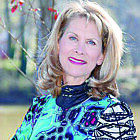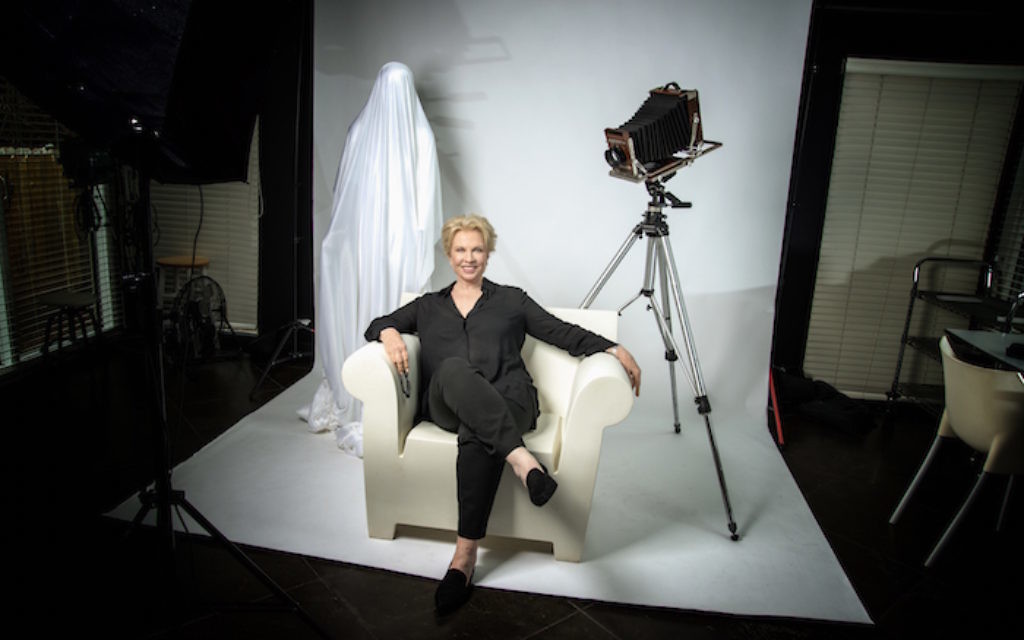Leibowitz Breaks Boundaries With Color, Light
The photographer's home provides an off-beat space for the display of her nude works and other images.
Sandy Springs resident Harriet Leibowitz can be found working in her monochromatic home photography studio or hanging upside down on a yoga swing from the center of the ceiling.

It’s a light-filled room that is energized by the activity, whether it is making pictures, celebrating the holidays or quietly meditating.
The remainder of the house zings with Leibowitz’s works: floor-to-ceiling figures, colored squares, nudes, dancers and flowers. She calls them “scrims of colors — all about light, space, movement and mystery.”
Get The AJT Newsletter by email and never miss our top stories Free Sign Up
Leibowitz is constantly searching for projects for the interpretation of her own observations. She has works in public and private collections: the High Museum of Art, the Birmingham Museum of Art, the Museum of Contemporary Art of Georgia, the Sir Elton John Photography Collection, Hartsfield-Jackson Atlanta International Airport, the Metro Atlanta Chamber, IBM, Coca-Cola and the Four Seasons Hotel.
Her printed media exposure includes Vanity Fair, Vibe, “The Male Nude,” “The Nude in Contemporary Photography,” Atlanta Magazine, and Town & Country. She is represented in Georgia by Alan Avery Art.
She is known for pushing the edge of her film, resulting in provocative and sensual studies of gender and self-identity.
The house itself is an engaging backdrop for her work. There is a Ben Smith woodcut, Asian chests, a mid-century modern chandelier, a salon wall of classic photographs, and displays of assembled Legos and family photos.
Her husband, Henry, a retired orthodontist and accomplished potter, displays his ceramics. His work creates organic spaces to complete the pleasing and offbeat vision.
Jaffe: You’re a local Grady High School gal. Were you always artistic?
Leibowitz: I was always involved in creative endeavors and spoke my own language. Originally, I painted, particularly figures and faces, but explored all media until I found the magic and power in a photograph. My formal training is an M.F.A. degree from Georgia State and a B.S. degree from Boston University. I was able to immerse myself in the history and philosophy of photography. It enabled me to be fearless and to embrace experiment and examination as part of the creative process.
Jaffe: What about photography specifically appeals to you?
Leibowitz: It’s a medium for expression. I capture the light, the space, the moment. Photography is like magic in expressing an idea. Photography plays with reality and perception.

Jaffe: How has technology affected your photography?
Leibowitz: I originally had a dark room. Now it’s a computer room. My studio is where I work on making the magic happen. It’s where my models and I work together to achieve a synchronicity that has meaning and delights the eye and mind. For me, it happens in the camera without a lot of post-processing.
Jaffe: You have a reputation for being rather edgy. From where does that stem?
Leibowitz: So here you will see most of my work centers around form and figures. Edgy? A photographer should be able to capture the other side of what you expect. It’s my job as an artist to enlighten, inform and inspire, to bring to an image more than what is physically present. There is a dark side. There is a bright side. I create a vision, but it is open for anyone’s interpretation. Everyone can bring their own experience to an image and find meaning that is particular to them.
Jaffe: Some of your work represents the LGBT community. Would you call that your niche?
Leibowitz: In the 1990s I began exploring form and finding light in the inherent beauty everyone possesses. The images are about optimism, honor and dignity. Many of the models are gay, but it makes no difference to me if they are gay, straight or trans. They gave generously and freely, and we made work that transcends the physical and addresses the humanity in all of us.
Jaffe: Who are some of your favorite photographers?
Leibowitz: I find inspiration from artists who are not necessarily photographers. I’m a fan of Kandinsky, who is credited with creating the first abstract paintings based on an inner spirit and beauty. Robert Longo, who examines gender, power and angst, is another artist that I admire. And let me not forget Francis Bacon and his highly emotional and rough paintings.
As for photographers, I like Harry Callahan’s images of his wife. They are simultaneously tender and formal — the ultimate expression of an artist and his subject. I also adore the work of Gregory Crewdson, who sets an elaborate tableau. He shoots small-town America and cinematic large scenes with movie crews. His dramatic lighting makes for a surreal experience.
Jaffe: You have traveled the world, yet I don’t see any National Geographic-type photos.

Leibowitz: When I travel, I want to enjoy just that experience. On the other hand, photography has given me 35 years of worlds of experiences I would not have had otherwise. I certainly understand photographing what we witness. It creates a solid memory to testify that we have been there. It gives us the ability to hang on just a little longer. I just choose to assimilate the observation into my overall experience. I do have plenty of images of my travels; some of the places are just so overwhelming that I have to record them. My work is more something I create in my head than something I respond to.
Jaffe: What’s left for you to conquer?
Leibowitz: Not sure I can conquer anything, but I can certainly continue more exploration. The fun is in this process. I will always have questions about our perceptions and interpretations as opposed to what is really happening. My plan is to continue making images that transcend their aesthetic and tell a meaningful story.
Jaffe: Do people mistake you for world-famous photographer Annie Leibovitz?
Leibowitz: Sometimes. … People do ask me if I am related. It’s a logical question






comments